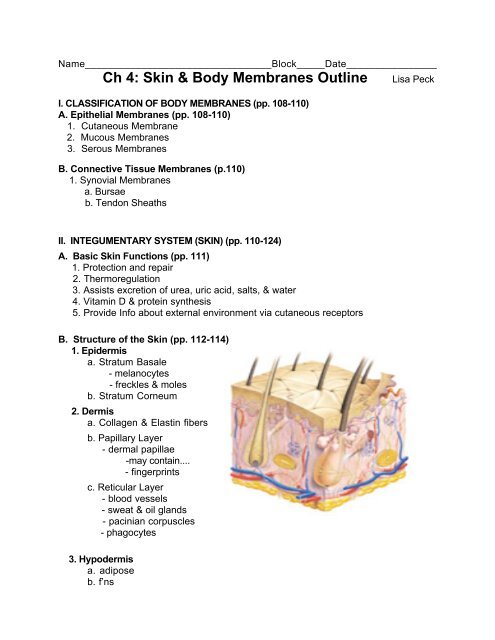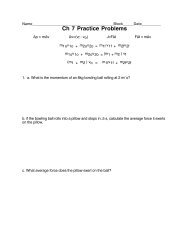Ch 4: Skin & Body Membranes Outline
Ch 4: Skin & Body Membranes Outline
Ch 4: Skin & Body Membranes Outline
Create successful ePaper yourself
Turn your PDF publications into a flip-book with our unique Google optimized e-Paper software.
Name_________________________________Block_____Date________________<br />
<strong>Ch</strong> 4: <strong>Skin</strong> & <strong>Body</strong> <strong>Membranes</strong> <strong>Outline</strong> Lisa Peck<br />
I. CLASSIFICATION OF BODY MEMBRANES (pp. 108-110)<br />
A. Epithelial <strong>Membranes</strong> (pp. 108-110)<br />
1. Cutaneous Membrane<br />
2. Mucous <strong>Membranes</strong><br />
3. Serous <strong>Membranes</strong><br />
B. Connective Tissue <strong>Membranes</strong> (p.110)<br />
1. Synovial <strong>Membranes</strong><br />
a. Bursae<br />
b. Tendon Sheaths<br />
II. INTEGUMENTARY SYSTEM (SKIN) (pp. 110-124)<br />
A. Basic <strong>Skin</strong> Functions (pp. 111)<br />
1. Protection and repair<br />
2. Thermoregulation<br />
3. Assists excretion of urea, uric acid, salts, & water<br />
4. Vitamin D & protein synthesis<br />
5. Provide Info about external environment via cutaneous receptors<br />
B. Structure of the <strong>Skin</strong> (pp. 112-114)<br />
1. Epidermis<br />
a. Stratum Basale<br />
- melanocytes<br />
- freckles & moles<br />
b. Stratum Corneum<br />
2. Dermis<br />
a. Collagen & Elastin fibers<br />
b. Papillary Layer<br />
- dermal papillae<br />
-may contain....<br />
- fingerprints<br />
c. Reticular Layer<br />
- blood vessels<br />
- sweat & oil glands<br />
- pacinian corpuscles<br />
- phagocytes<br />
3. Hypodermis<br />
a. adipose<br />
b. f’ns
C. <strong>Skin</strong> Color (pp. 116)<br />
1. Pigments<br />
a. Melanin<br />
b. Carotene<br />
c. Oxygen-rich Hemoglobin<br />
2. Due to emotional state or disease<br />
a. cyanosis<br />
b. erythema<br />
c. pallor<br />
d. jaundice<br />
e. hematomas<br />
II. INTEGUMENTARY SYSTEM (SKIN) (pp. 110-124)<br />
D. Appendages of the <strong>Skin</strong> (pp. 116-120)<br />
1. Cutaneous Glands<br />
a. Sebaceous (Oil) Glands<br />
b. Sweat Glands<br />
-Eccrine Glands<br />
- Apocrine Glands<br />
2. Hairs and Hair Follicles<br />
a. matrix<br />
b. arrector pili<br />
3. Nails<br />
a. growth<br />
E. Homeostatic Imbalances of the <strong>Skin</strong> (pp. 120-124)<br />
1. Decubitus Ulcers<br />
2. Infections and Allergies<br />
a. Athlete's Foot<br />
b. Boils and Carbuncles<br />
c. Cold Sores<br />
d. Contact Dermatitis<br />
e. Impetigo<br />
f. Psoriasis<br />
3. Burns<br />
4. <strong>Skin</strong> Cancer<br />
a. types<br />
b. ABCD Rule<br />
III. DEVELOPMENTAL ASPECTS OF SKIN AND BODY MEMBRANES (pp. 124)<br />
A. Adolescence<br />
B. Old Age<br />
1. Alopecia- hair thinning and baldness<br />
2. Graying hair
















